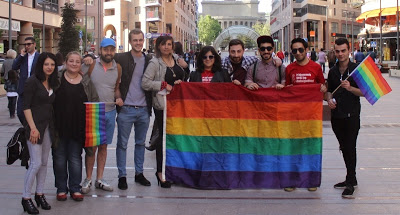"Ermenistan’da LGBTİ'ler sorun yaşamamak için gizleniyor"


23. LGBTİ Onur Haftası programı devam ediyor. Pazar günü gerçekleşecek ‘Onur Yürüyüşü’yle sona erecek olan Onur Haftası’nın bu sene Ermenistan’dan bir konuğu vardı. Pink Armenia Proje Koordinatörü Nvard Magaryan, cinsel ve etnik kimlik üzerine çalışan Meltem Naz ve gazeteci, yazar Karin Karakaşlı’yla birlikte Ermenistan’daki LGBTİ mücadelesini konuştu. Bugün Fransız Kültür Merkezi’nde gerçekleşen panel öncesinde Magaryan’la buluştuk ve LGBTİ’lerin karşılaştığı zorlukları konuştuk.
Yerevan’da başlayan ve başka şehirlere de yayılan protestoları nasıl değerlendiriyorsun?
Elektrik ücretleriyle ilgili bir mücadele bu. Bugüne kadar pek çok kişi yaralandı, ilk defa bu kadar fazla sayıda barışçıl eylemci gözaltına alındı. Polis ilk defa tazyikli su kullandı. Ama polisin vahşi ve sert tutumuna rağmen birçok insan eyleme devam ediyor. Elektrik zammı henüz geri alınmadı, insanlar bu yüzden halen sokakta. Meclise ve Devlet Başkanı’nın konutuna giden yol eylemciler tarafından kapatılmış durumda. Yani eylemde kullanılan ‘Electric Yerevan’ sloganı gibi durum hala ‘elektrikli’. İlginç olansa insanların ulusal olarak birliktelik hissiyle hareket etmesi.
Yerevan protestolarında farklı gruplar görünür değil
Yerevan’da daha önce bu ölçekte polis şiddeti yaşanmış mıydı?
Serj Sarkisyan’ın Devlet Başkanı 2008 seçimlerinde yaşanan protestolarda polis daha şiddetliydi. Ama polis ilk defa barışçıl göstericiler tazyikli suyla müdahale etti ve ilk defa sivil polisler insanları gözaltına aldı. Ayrıca gazetecilere ve insan hakları savunucularına yönelik bir şiddet uygulandı.
 Nvard Mafaryan
Nvard Mafaryanİki farklı ülke arasında benzerlik kurmak sorunlu olabilir ama, Yerevan’da yaşananlar bir yandan 2013 Gezi Direnişi’ni hatırlatıyor. Gezi’nin bir özelliği de daha önce bir araya gelmemiş toplumsal hareketlerin birbirine temas edebilmesiydi. Yerevan’da böyle bir durumdan bahsedebilir miyiz?
Alanda LGBTİ aktivisti, feminist, anarşist gibi pek çok farklı gruplardan kişiler var. Ama eksik olan şu: ‘Gezi’de herkesin parkta kendine ait bölgeleri vardı, bayraklarıyla oradalardı. Ama Yerevan’da bu gruplar görünür değil. Yani kişisel olarak onları tanımıyorsan kim olduklarını anlamazsın. Sadece anarşistler protestonun ilk günlerinde görünürdü ama orada da büyük bir tartışma çıktı ve bundan sonra sadece Ermenistan bayraklarının alanda olması gerektiğine dair karar verildi.
Ermenistan’ın % 91’i LGBTİ haklarının sınırlanması gerektiğini düşünüyor
Ermenistan’da LGBTİ bireylerin en çok yüz yüze geldiği sorunlar neler?
En büyük sorun, toplumda geniş bir alana yayılmış olan homofobi. Ermenistan Anayasası’nda yapılması gereken reformlarla ilgili 2014’te yapılmış bir araştırmada cinsel azınlıklara yönelik sorular da vardı. Çeşitli cinsel yönelimlere sahip insanlara nasıl davranıldığı, haklarında neler düşünüldüğüne dair sorular. Bu araştırmaya göre, toplumun %91’i LGBTİ haklarının sınırlanması gerektiğini düşünüyor.% 8’i durumlarının iyi olduğunu, sadece %1’i LGBTİ’lerin daha fazla hakka sahip olmaları gerektiğini düşünüyor. Bu durum elbette cinsellik konusunda eğitimsiz olmaktan, ataerkil yapının ve önyargıların yaygın olmasından ileri geliyor. Ama asıl endişe yaratan devlet destekli homofobi. Vekillerin çoğu lgbt sorunlarını sıklıkla manipüle ediyor. Şu anda Yerevan protestolarında yer alan arkadaşlarım, bu vekillerin yanlış bilgilerle kalabalığı manipüle edeceğinden korkuyor.
Öte yandan LGBTİ meselesi batı ve doğu arasında tartışma nedeni oluyor. 2013’te Ermenistan, AB Ortaklık Anlaşması’ndan vazgeçerek Rusya liderliğindeki Gümrük Birliği’ne üye oldu. Bu ekonomik bir birlik ama aynı zamanda sosyal ve siyasal bir birlik. Rusya’da insan haklarını ihlal eden yasaların Ermenistan’a da birebir uygulanacağından korkuyoruz. Çünkü Propaganda Yasası’, ‘Ajanlık Yasası’ gibi yasalarda bunu daha önce de yaşadık.
Peki gündelik hayatta durum nasıl?
LGBTİ’lerin toplumdaki görünürlüğü çok az. İnsanlar daha az sorunla yüz yüze gelmek için cinsel yönelimlerini saklıyor. Eğer açıkça gey, lezbiyen ya da transsan sokakta taciz, nefret suçu, gasp ve şantaj gibi şeylerle karşılaşabilirsin. Ayrıca LGBTİ toplumunun en görünür üyeleri olan translar - ki çoğu başka şansları olmadığı için seks işçisi olarak çalışıyor – neredeyse her gün fiziksel saldırılara maruz kalıyor. Bu saldırılar adli makamlara doğru düzgün taşınamıyor, çünkü polis bu davaları davacıların aleyhine çeviriyor. Yani nefret suçuna maruz kalmış bir seks işçisiysen ve polise gidersen, polis seks işçiliği yasaya göre yasadışı olduğu için bu şiddetin failini soruşturmak yerine sana dava açıyorlar.
LGBTİ bireyler göç ediyor
Bu baskıcı ortamdan kaçıp başka ülkelere giden LGBTİ’lerle ilgili bir veri var mı?
Pink Armenia olarak, LGBTİ göçünün ekonomik göstergeleri üzerine bir araştırma yapmıştık. Buna göre 2013-2014 yılları arasında yaklaşık 5 bin LGBTİ Ermenistan’dan göç etmiş.
Pink Armenia, Ermenistan’da toplumsal cinsiyet mücadelesi konusunda politika üreten tek örgüt. Baskıya maruz kalıyor musunuz?
Özellikle medyada nefret söylemi çok hızlı yayılıyor. Homofobi, Transfobi ve Bifobi’ye karşı Uluslarası Dayanışma Günü’nde (IDAHOT) spontane bir eylem yaptık ve fotoğrafını paylaştık. O fotoğrafın altındaki yorumları okumalısınız. “Bu insanları yakmak gerek” diyen, IŞİD’i davet edenler... Baskı her zaman fiziksel saldırı olarak ortaya çıkmasa da LGBTİ’ler korkuyor, çünkü cezasızlık atmosferi gittikçe artıyor ve siyasetçiler tarafından kamusal alanda destekleniyor. 2012’deki bar saldırısında olduğu gibi fiziksel saldırıya dönüşmesi an meselesi.

İki ülke arasındaki benzerlik ataerkil sistem
Türkiye ve Ermenistan’daki LGBTİ hareketlerinin farkları ve benzerlikleri nedir sana göre?
Ermenistan’daki en büyük farklılık LGBTİ’lerin görünür olmaması. Pazar günü buradaki Onur Yürüyüşü’ne katılacağım ama Ermenistan’da yürüyüş yapamıyoruz.
Türkiye’de LGBTİ haklarını açıkça savunan siyasi partiler var Türkiye’de, halbuki Ermenistan’da durum öyle değil.
Benzerlik olarak da iki ülkede nefret suçunun yasal olarak kabul edilmediğini söylemek gerek. İkinci olarak da, daha küçük şehirlerde ve köylerde yaşayan LGBTİ bireyler, görece daha özgür yaşamak için büyük şehirlere göç ediyor. Ve en büyük benzerlik ataerkil sistem. İki ülkenin kültüründe de ‘gerçek erkek’e dair birtakım stereotipler var.


